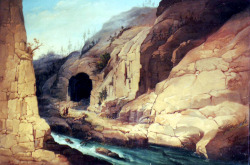Peștera Dâmbovicioara
Dambovicioara Cave
Useful Information
| Location: |
DC 22, Dâmbovicioara 117356.
1 km north of Dambovicioara village. Just off the E 574. Southern part of Piatra Craiului Mountains. (45.4439529, 25.2228201) |
| Open: |
All year Mon-Fri 9:30-16, Sat, Sun 9-17. 01-JAN 10:30-17. 02-JAN 9:30-17. 25-DEC 10:30-16. 26-DEC 9:30-16. [2025] |
| Fee: | free. Guides: Lei 10.000. [2025] |
| Classification: |
 Karst Cave Karst Cave
|
| Light: |
 Incandescent Incandescent
|
| Dimension: | L=555 m, T=10-12 °C. |
| Guided tours: | self guided |
| Photography: | allowed |
| Accessibility: | no |
| Bibliography: |
Choppers (2003):
Romania Whitsun 2002,
Cerberus Spaeological Socirty Journal Vol 26 (4) 25-32
|
| Address: | Peștera Dâmbovicioara, DC 22, Dâmbovicioara 117356, Tel: +40-744-524-874. |
| As far as we know this information was accurate when it was published (see years in brackets), but may have changed since then. Please check rates and details directly with the companies in question if you need more recent info. |
|
History
| 1579 | cave first mentioned in a report on the cave during the Mihnea Turcitul ruling. |
| 1767 | scientific work about the cave written by J. Fridvalsky: Mineralogia Magni Principatus Transilvaniae. |
Description

Peștera Dâmbovicioara (Dambovicioara Cave, Dambovicioarei) is a rather small cave in an impressive karst area. The surrounding mountains of Fagras, Piatra Craiului and Leaota are the source of rivers, which eroded deep valleys and gorges into the limestone. This is the biggest gorge complex of Romania. About one kilometre north of Dâmbovicioara village, at the road through the Dambovicioara Gorge, lies the most famous of many small and medium-sized caves, Dambovicioara Cave.
Dambovicioara Cave is only 555 m long, a single passage which ascends continually from the entrance, a typical river passage. The passage is mostly 3 to 4 m wide and 4 to 5 m high. The first 250 m of the cave are developed with an elevated trail and railings, and there is electric light. The development was many decades ago and so the cave is actually a little rundown, the iron railings and gates are rusty. The ceiling is always higher than two meters, so it is an easy walk of 500 m, in and back again. It is possible to visit the cave in a self-guided way, but a guide may be hired. At the end of the developed section there is an iron bar gate which gates the rest of the cave but allows bats to fly through.
The cave is not gated, and it was open like this for visitors over centuries. This means there are no virgin speleothems left, what was there once, is now broken or stolen. The cave contained some remains of cave bear (Ursus spelaeus).
According to local lore the cave was used by the locals as a hideout for centuries. At one point a hermit lived in the cave. Robbers used it as a hideout, and bears hibernated in the cave. During the First World War it served as a shelter for two famous outlaws, Fulga and Budac. They were famous Robin Hoods, well known for robbing the wealthy and giving the money to the poor. All in all, any possible legend is told about the cave.
- See also
 Search DuckDuckGo for "Cave Dambovicioara"
Search DuckDuckGo for "Cave Dambovicioara" Google Earth Placemark
Google Earth Placemark OpenStreetMap
OpenStreetMap Peștera Dâmbovicioara - Wikipedia (visited: 07-MAY-2025)
Peștera Dâmbovicioara - Wikipedia (visited: 07-MAY-2025) Dambovicioara Cave: an adventure in the heart of Piatra Craiului (visited: 07-MAY-2025)
Dambovicioara Cave: an adventure in the heart of Piatra Craiului (visited: 07-MAY-2025) Dâmbovicioara Cave (visited: 07-MAY-2025)
Dâmbovicioara Cave (visited: 07-MAY-2025) Plimbări cu bicicleta pe drumul spre peştera Dâmbovicioara
Plimbări cu bicicleta pe drumul spre peştera Dâmbovicioara  (visited: 07-MAY-2025)
(visited: 07-MAY-2025)
 Index
Index Topics
Topics Hierarchical
Hierarchical Countries
Countries Maps
Maps